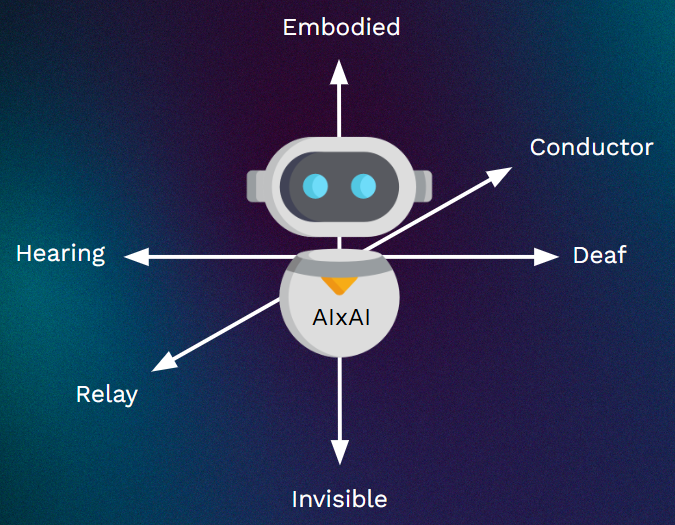The dream of seamless sign language translation has long been a major goal in the sign language industry. With advancements in artificial intelligence, we are now on the cusp of achieving automated interpreting by artificial intelligence (AIxAI). Unlike static text translation, AIxAI operates in dynamic, real-time social interactions where the expectations placed upon it are significantly higher.
But what are these expectations? Rather than prescribing a fixed set of rules, we can explore three key axes of role-space1 that shape how AIxAI functions in human communication. Each axis represents a spectrum of possible approaches that AI-powered interpreting systems must navigate in order to be effective.
Role-space theory helps us understand these challenges by framing interpreters not only as passive layers but also as active communicators. Communication is not solely an exchange between a speaker and a signer; rather, it involves a complex interplay that includes the machine as an interactive participant. AIxAI systems must therefore be designed to integrate seamlessly into these exchanges, adapting dynamically to the evolving context and communicative needs of all parties involved.

Participant Alignment: Who Does the Machine Represent?
With which communicator does the machine align with? Is it a tool used by signers to communicate with speakers? Or is it a tool used by speakers? Consider these scenarios:
- A Deaf user walks into a pharmacy and signs their request to an AI-powered sign language recognition system. The system translates the request into spoken language for the hearing pharmacist.
- A hearing doctor uses an AI system to communicate with a Deaf patient. The system’s interface might prioritize the doctor’s spoken instructions and translate them into sign language.
The ideal AIxAI system should be flexible enough to shift alignment depending on context. If an AI tool rigidly favors one party, it risks failing in nuanced conversations where mutual accommodation is required.
Interaction Management: How Does AI Mediate Conversation?
How much does the machine manage the natural flow of dialogue? Does it interrupt either communicator for clarifications or corrections? Does it help enforce turn-taking? Does it intervene when idiomatic expressions or cultural differences might lead to misunderstandings?
An important example is a job interview. A Deaf candidate using AIxAI may need it to handle technical jargon effectively, while also ensuring they have equal opportunity to interject, clarify, or expand upon their responses. The level of interaction management must be adaptable, allowing users to calibrate the AI’s involvement to their needs.
Presentation of Self: Is the AI Invisible or a Communicator?
Does the machine behave as a neutral, transparent intermediary? Or does it take on the role of a communicator in its own right?
A completely invisible AI remains purely a conduit, providing translations without any self-referential acknowledgement. This approach ensures that communication remains between the human participants, but it may limit the AI’s ability to flag misunderstandings or adapt to the conversation dynamically.
Whereas an AI acting as a communicator might acknowledge itself and may even introduce itself at the start of an interaction (e.g., “I am your AI interpreter”). This might make communication smoother, but it also raises ethical questions about AI’s perceived agency in conversations.
Imagine an AIxAI system used in legal settings. If the AI translates but never acknowledges its presence, does it risk misleading participants into assuming the translation is flawless? On the other hand, if the AI speaks as if it is an independent actor, does this disrupt the perceived neutrality of the interpreting process?
Traversing Role-Space: The Future of AIxAI
Before we can truly call these emerging technologies AIxAI, they must be capable of moving across role-space by adjusting alignment, interaction management, and self-presentation based on the needs of the context. A rigid system that cannot adapt risks being a mere novelty rather than a transformative tool of accessibility.
For AI-powered interpreting to become a reliable, accepted solution in everyday communication, developers must embrace flexibility. Whether it’s a casual conversation between friends, an important medical appointment, or a high-stakes witness testimonial, AIxAI must navigate these shifting sands of expectations with responsiveness, cultural sensitivity, and user control.
Only then can AI-powered sign language translation move beyond novelty and become a true bridge between languages and communities.

Comments are closed.